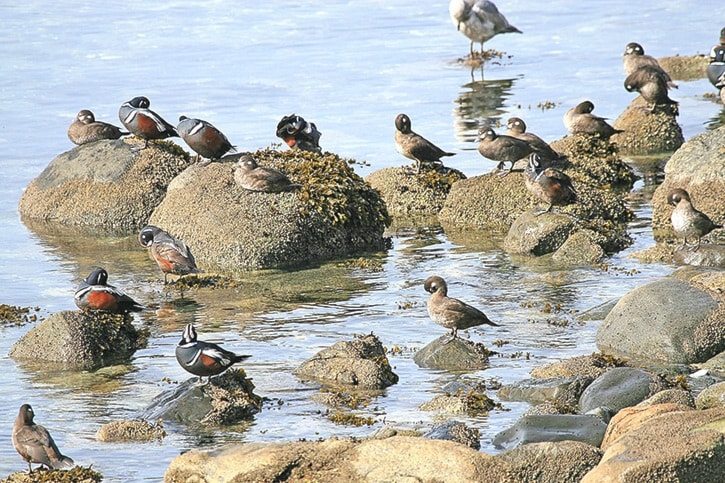There’s something fishy going on with male Harlequin ducks that call the White Rock/Crescent Beach shoreline home.
And local scientist Sean Boyd is determined to find out what’s driving the trend in what he described as “probably the best-studied” population of the sea ducks in the world.
The faithful birds – they typically mate for life – have been monitored here since about 1986.
“Up until 2006, the males were coming back every year (to molt),” Boyd, a research scientist with Environment Canada’s Science & Technology Branch, said earlier this month, as he surveyed the Kwomais Point coastline from West Beach. “Then, they stopped.”
The Harlequins winter along the rocky shorelines, foraging on small crustaceans, and migrate inland every spring – they’ve just recently started to move – to breed on mountain streams. Historically, the males return to molt in June, followed about two months later by the females.
In recent years, however, the males are going elsewhere to molt and returning one to two months after the females.
 Boyd’s theory is the males have changed their habits as a result of one or both of two things: an increase in recreational water sports that bring participants within 100 metres of the shoreline, disturbing the molting birds and preventing them from foraging for long periods; and, a new trend of eagles nesting in the area.
Boyd’s theory is the males have changed their habits as a result of one or both of two things: an increase in recreational water sports that bring participants within 100 metres of the shoreline, disturbing the molting birds and preventing them from foraging for long periods; and, a new trend of eagles nesting in the area.
“They never used to nest here,” Boyd said of the raptors, noting he now counts five or six nests in the trees above the coastline between West Beach and Crescent Beach, and, on some days, has spotted up to 100 eagles foraging along the beach.
If they are making the Harlequins nervous, the ducks may simply be opting not to take any chances.
“It’s more predation risk,” Boyd said. “Why risk being captured or predated if you can go somewhere else and be safe?”
Boyd expects to solve the mystery within the next two months, through a project jointly funded by Environment Canada and the Sea Duck Joint Venture.
In March, 14 of the local Harlequins were implanted with small satellite transmitters and released back to the coast. The transmitters enable Boyd to live-track each of the marked ducks’ movements and “site-fidelity” for two years.
It is a companion project to a larger one in which 18 Harlequins near Kitimat were marked in April 2014, and 22 were marked at Hornby Island in March of this year.
An additional incentive for tracking the local ducks has to do with a large decline in the wintering population. Back in the 1980s, it numbered between 110 and 120 ducks. These days, it’s down to about half that – only 50 or 60.
Earlier this month, five of Boyd’s marked group were still in the area. Transmitter data last week from the other marked ducks showed a female 550 kilometres away, in Jasper National Park; a pair just south of Wells Gray Provincial Park; a male just north of Salmon Arm; a male just south of Gold Bridge; a female just north of Cowichan Lake (likely nesting); and a pair just south of Bellingham.
The data also shows that one female tracked to just south of Princeton has died.
 Boyd said most people he chats with in the course of surveying the ducks have no idea of the local area’s significance to water birds.
Boyd said most people he chats with in the course of surveying the ducks have no idea of the local area’s significance to water birds.
“I would say 99 per cent of them don’t even know we have Harlequin ducks,” he said.
“We are on the most important wintering area for water birds. You could have 100,000 marine birds in this area on a given day. We’re living right on an incredible site and I don’t think a lot of people appreciate that.”
He acknowledged the local Harlequin population is “a drop in the bucket,” but it would be shame to lose them nonetheless.
“They are part of the ecosystem. This might be a precursor of what’s going to happen in other areas,” he said.
Another reason to track the ducks is a bit more ominous: to develop a baseline in the event of a toxic spill from ships or trains. Boyd noted a study of Harlequins and Barrow’s goldeneye following the 1989 Exxon Valdez disaster showed the bird populations didn’t even start to recover until 20 to 25 years later.
“If it did happen (in Semiahmoo or Boundary Bay), it would be disastrous,” he said.
